
Three Little Piggies deluxe
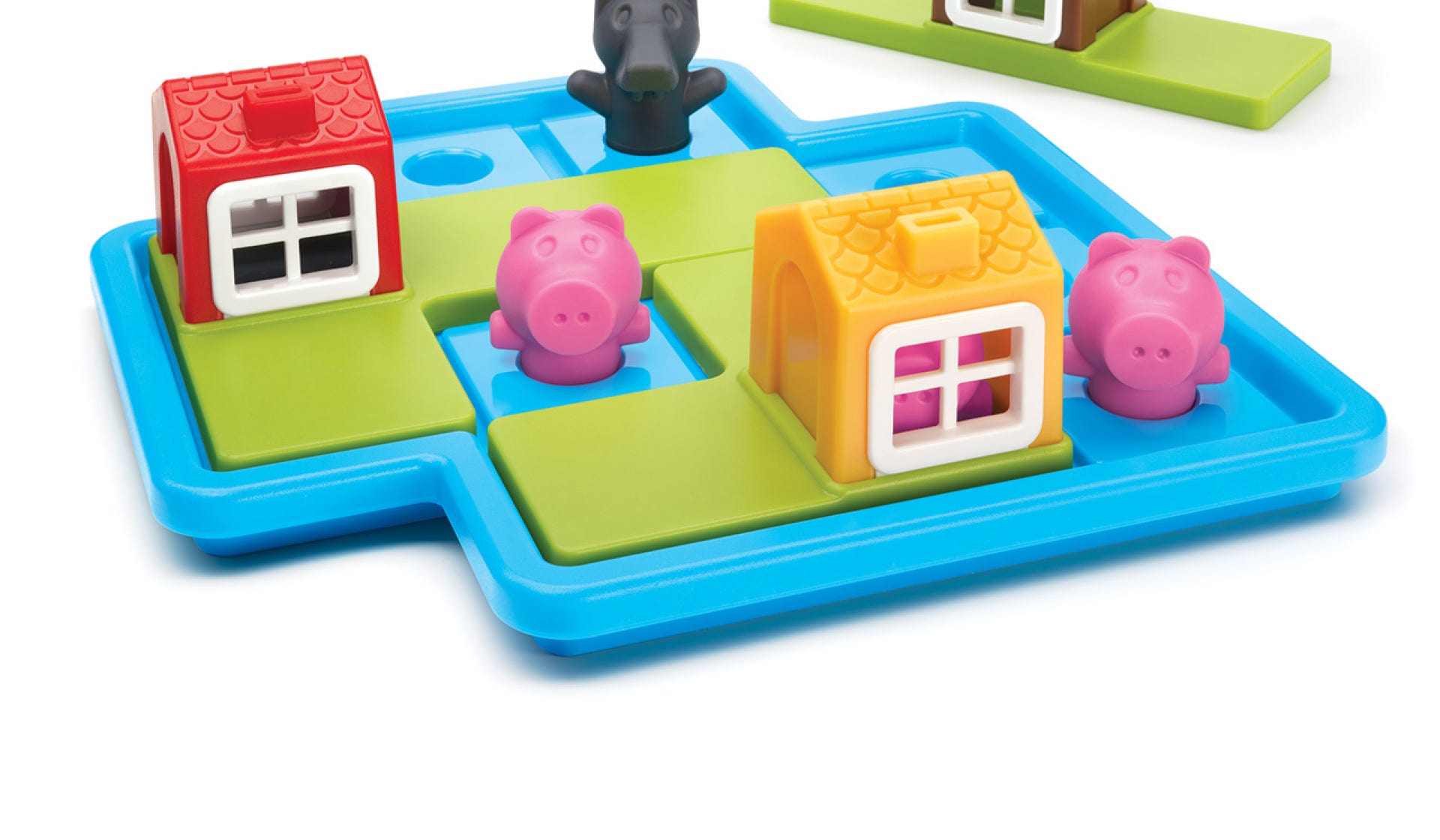
The story behind the creation of Three Little Piggies Deluxe
Raf Peeters, January 2015
Three Little Piggies is a new SmartGame I designed specifically for preschool children (age 3-6).
I always love to design for little kids, because it allows me to focus even more on simplicity than I normally do. You don’t need hard challenges or a complex mechanical solution to impress young kids. All you need is a good idea. Something that fascinates children. And luckily, the younger children are, the more they are still fascinated about all kind of small things that adults find normal.
HOME SWEET HOME
The idea was to make a puzzle game where characters are hidden. I already explored this concept with Safari and Pirates, but those games are too hard for children of age 3. Once they have hidden something underneath a puzzle piece, they “forget” that it’s there. This means that when they can’t solve a challenge, they think that probably the last puzzle piece was placed wrong, although it might have been the first puzzle piece.
To solve this issue, I didn’t wanted to hide characters completely, but keep them a little visible. For that purpose, each puzzle piece features a house. Even when the character is hidden inside a house, it’s still visible through the windows. To keep things solvable for very young children, I limited the number of puzzle pieces to 3, beating my previous record in minimum number of pieces. Maybe next year I will try to come up with a logic puzzle with only 2 pieces.
I can’t remember at which point the theme came into play. 3 characters, 3 houses, it was kind logical that the theme would be the fairy tale of “Three Little Pigs”. The shape of the game board was specifically chosen to make the right orientation clearer to little children. All corners have a missing square except for one (always bottom right). The houses are all the same, except for the color. We did try a different shape for each house, but it didn’t really add anything except cost. It only looked more complex. So although in the tale the houses are made of stone, straw or wood, all houses in the game are made of ABS plastics ;-)
DAY AND NIGHT
The theme made the addition of another character necessary. But the wolf is only used in half of the 48 challenges. For this reason the challenge booklet has two covers. On one side it’s daytime and the pigs are playing in the river. The challenge shows you the position of one or more pigs. The object of the game is to place the 3 puzzle pieces on the game board so that the pig(s) stay outside. The other side of the challenge booklet shows the nighttime and features 24 challenges with pigs AND the wolf. Now the object of the game is the opposite. All houses should be placed back on the game board so that each pig is hidden safely inside a house. The wolf should of course stay outside. As you might have noticed, you don’t always need to use all 3 pigs in a challenge. That means that often places on the game board or houses will stay empty when you solved it.
ONCE UPON A TIME
This game includes something extra that none of the other existing SmartGames have: a little, 24 page picture book (without text) with our version of the story of Three Little Piggies. All illustrations were made by my colleague Hans. He makes already most of the illustrations on the packagings (except the abstract ones), but now he had the opportunity to show that he is capable of much more. The illustrations on the packaging and inside the story book also solved another issue (although I hardly think that many children would consider it an issue). When we received the first color samples of the final product, we immediately preferred the version with the green tiles and the light blue game board. But some adults found that strange, because it would mean that the pigs are with their feet in the water. By making the river part of the story and the artwork, it’s no longer out of place.
update November 2015 : Three Little Piggies won the “Toy of the year award 2015” in both Belgium and Holland!
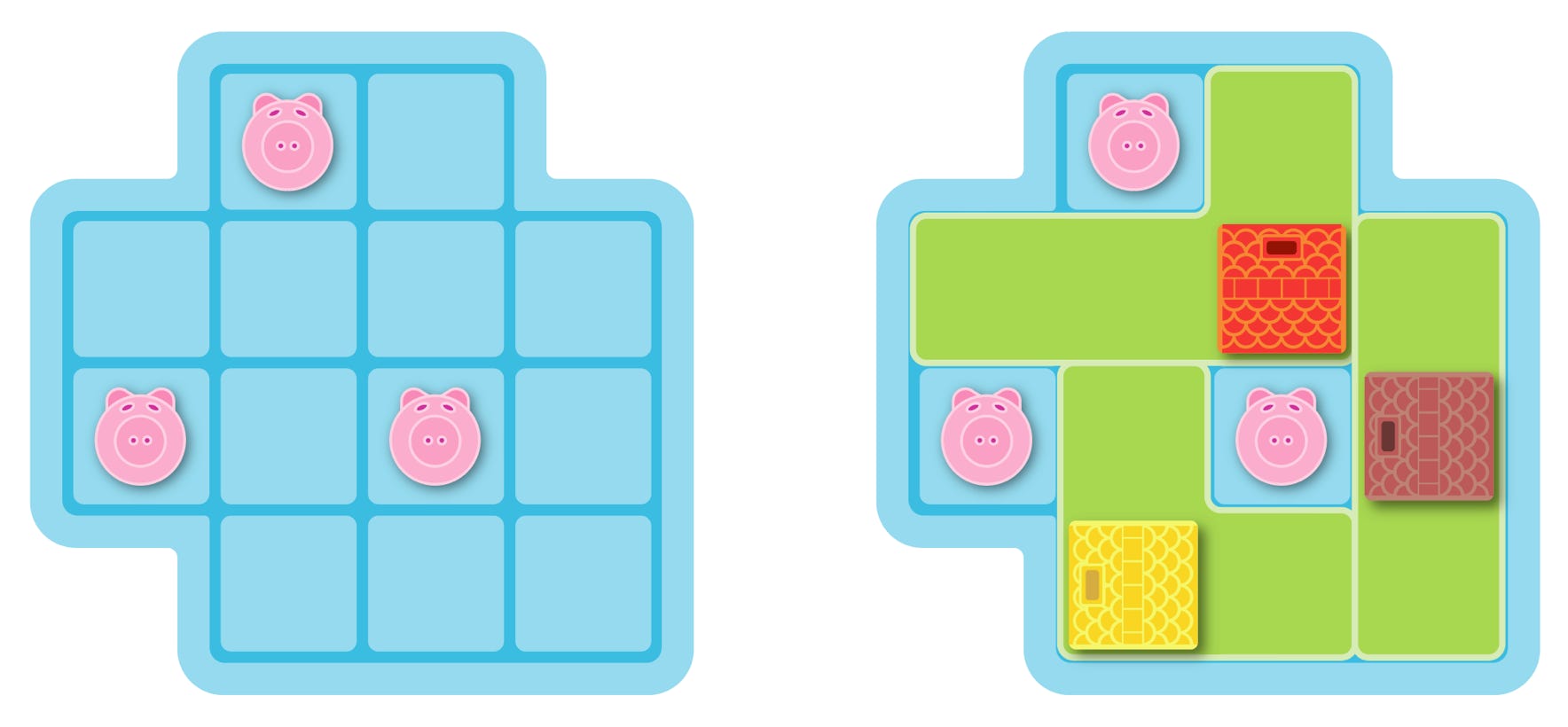
top left: example of a challenge and solution without wolf (daytime)
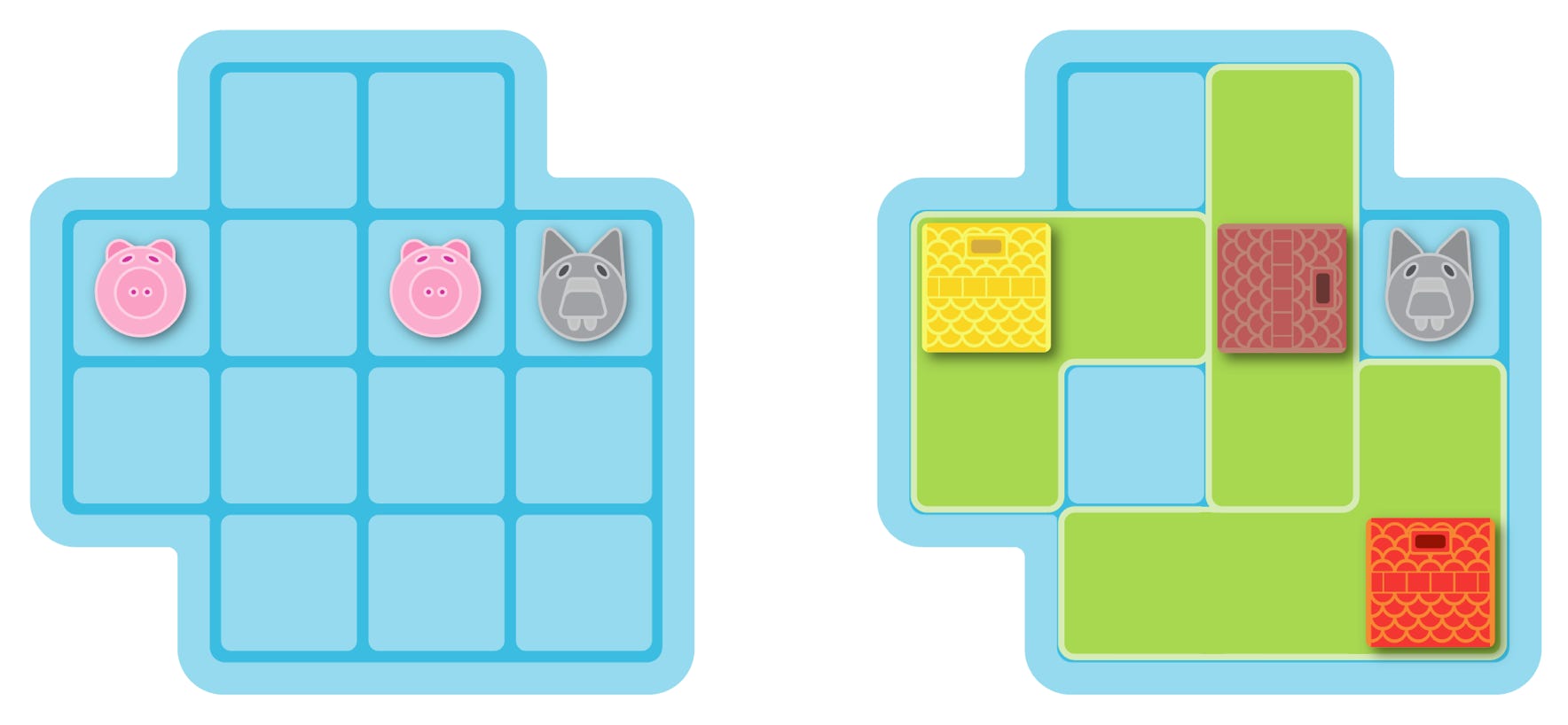
top left: example of a challenge and solution with the wolf (nightime)
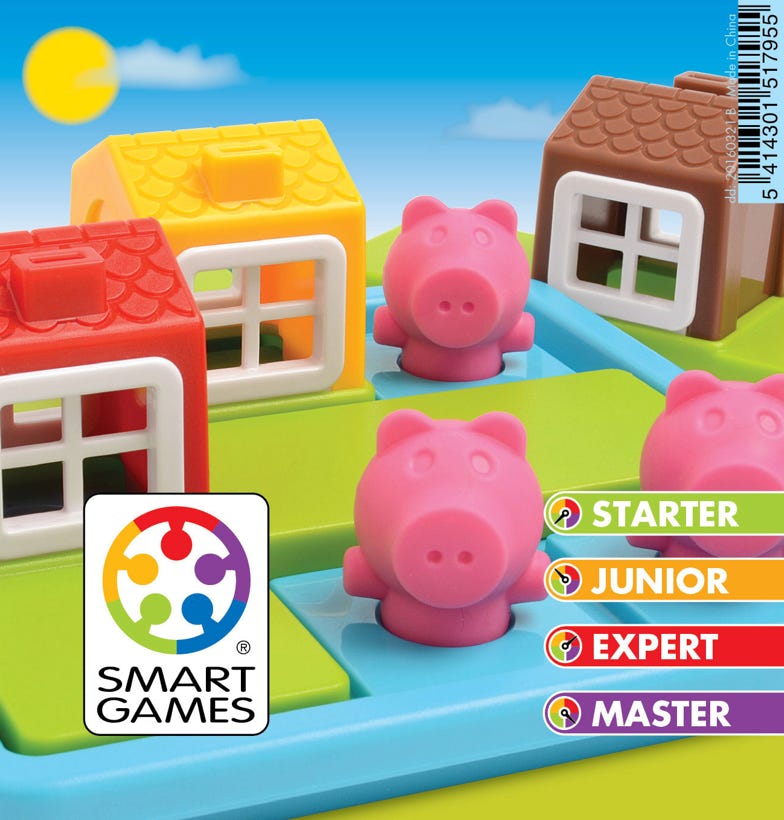
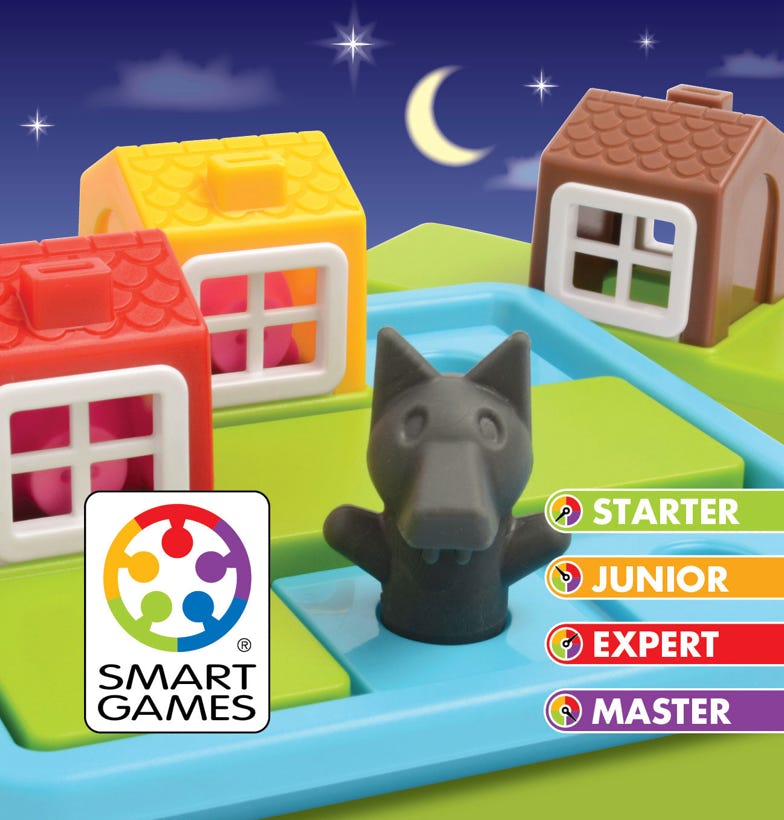
left: front cover with the day challenges without the wolf
right: backside cover with the night challenges and the wolf
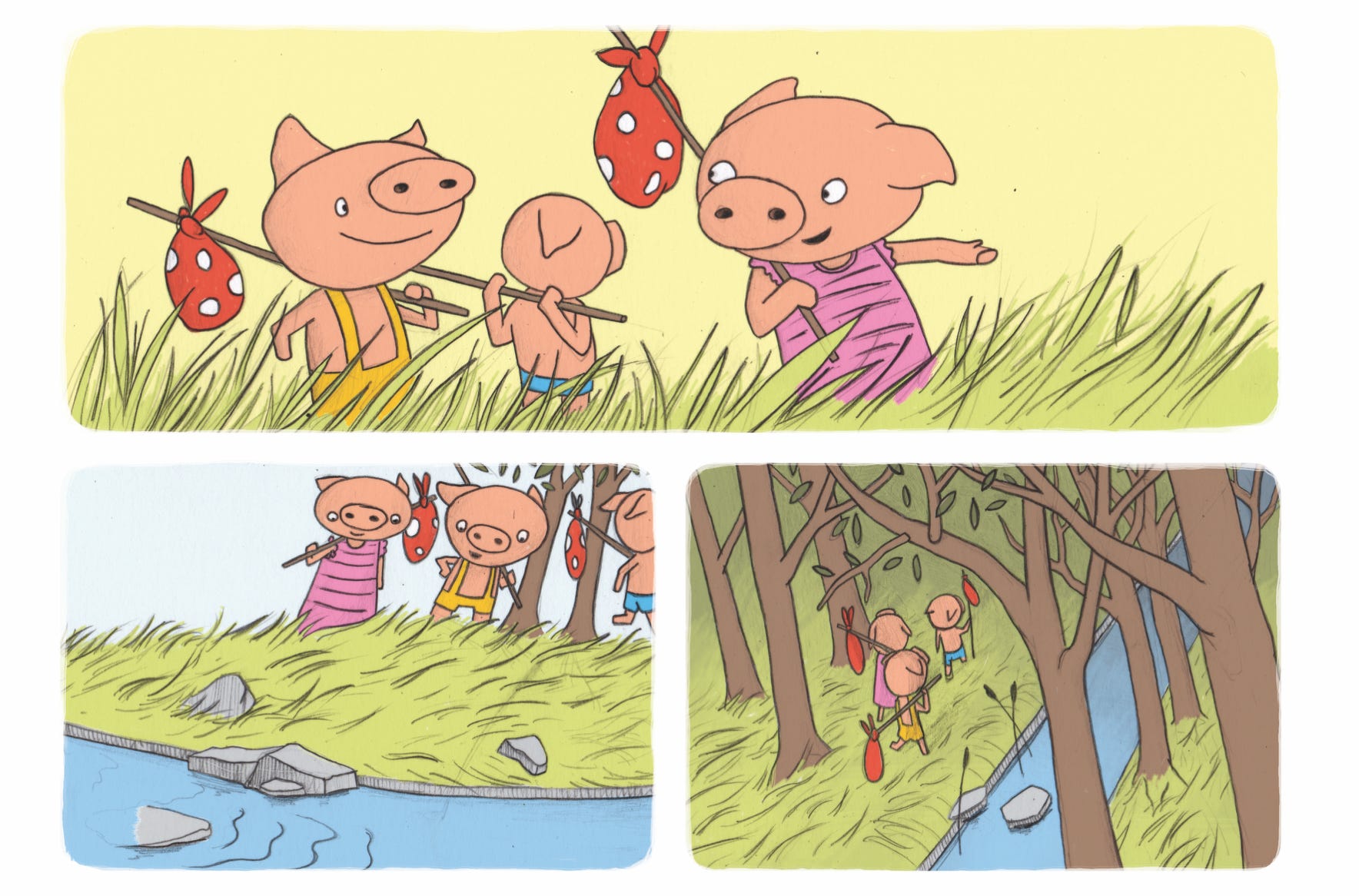
GAME RULES
Important! There are two types of challenges included in Smart Little Piggies: 24 with no wolf, and 24 featuring a wolf. The included booklet has 2 covers to show these separate challenges. Also, please make sure the game board is oriented correctly before playing, as shown in the images.
DAYTIME: CHALLENGES WITH ONLY PIGS (WOLF PIECE IS NOT USED):
The object of these challenges is to fit all the puzzle pieces on the board so that the selected pigs remain OUTSIDE their houses.
1) To set up the game, place pigs on the game board as indicated in the selected challenge. Sometimes only 1 or 2 pigs will be used, especially in early challenges; in these cases the remaining pigs will not be needed.
2) Place the 3 puzzle pieces on the game board, so that the pigs are playing OUTSIDE the houses. The indicated position of the pigs cannot be changed.
3) There is only 1 solution. You can find it on the backside of each challenge. If a challenge only shows 1 or 2 pigs, 1 or 2 squares will remain empty on the game board.
NIGHTTIME: CHALLENGES FEATURING THE WOLF:
The object of these challenges is to fit the three puzzle pieces on the board so that the houses COVER the pigs, protecting them from the wolf.
1) Set up each challenge by placing the pigs and wolf on the game board as indicated in the booklet. As before, some challenges don’t require all the pigs.
2) Place the 3 puzzle pieces on the game board, so that the houses fit over the pigs, keeping them safe INSIDE. The wolf should stay outside.
3) There is only 1 solution to each challenge. If a challenge uses only 1 or 2 pigs, some houses will stay empty. Two squares on the game board outside the houses will also stay empty in every challenge.
TIPS FOR PARENTS AND TEACHERS:
Although the solutions may seem obvious to an adult, they can be quite difficult for young children. Even setting up the game can be a big challenge for a three-year-old. Most children will need assistance when they start playing the game. You can encourage them by asking questions, such as:
• Where do you think this puzzle piece can be placed?
• Which house will fit over this pig?
• Why do you think this puzzle piece needs to be placed there?
If children still have problems with the challenges, it can be a good idea to start with recreating the solutions that are on the backside.
Website ©2024 Raf Peeters
Products and images: © Smart